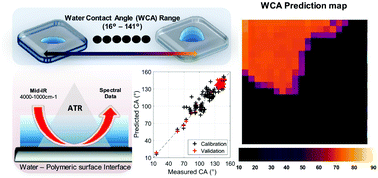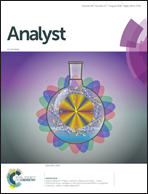Predictive modelling of the water contact angle of surfaces using attenuated total reflection – Fourier transform infrared (ATR-FTIR) chemical imaging and partial least squares regression (PLSR)†
Abstract
The static water contact angle (CA) quantifies the degree of wetting that occurs when a surface encounters a liquid, e.g. water. This property is a result of factors such as surface chemistry and local roughness and is an important analytical parameter linked to the suitability of a surface for a given bioanalytical process. Monitoring the spatial variation in wettability over surfaces is increasingly critical to analysts and manufacturers for improved quality control. However, CA acquisition is often time-consuming because it involves measurements over multiple spatial locations, independent sampling and the need for a single instrument operator. Furthermore, surfaces exposed to local environments specific to an intended application may affect the surface chemistry thereby modifying the surface properties. In this study, Attenuated Total Reflection–Fourier Transform Infrared (ATR-FTIR) chemical imaging data acquired from wet and dry polymer surfaces were used to develop multivariate predictive models for CA prediction. Partial Least Squares Regression (PLSR) models were built using IR spectra from surfaces presenting differences in the experimentally measured CA in the range 16°–141°. The best performing PLSR models were locally developed and combined to make a global model utilising wet IR spectra which performed well (R2p = 0.98, RMSECV ∼ 5°) when tested on an independent experimental set. This model was subsequently applied to IR spectra acquired from a surface exhibiting spatial differences in surface chemistry and the CA with a reasonable confidence and precision (prediction error within 10°), demonstrating the potential of this method for prediction of the spatially varying CA as a non-destructive in-line process monitoring technique.



 Please wait while we load your content...
Please wait while we load your content...